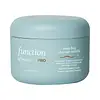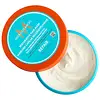What's inside
What's inside
 Key Ingredients
Key Ingredients

 Benefits
Benefits

 Concerns
Concerns

 Ingredients Side-by-side
Ingredients Side-by-side

Water
Skin ConditioningCetyl Esters
EmollientCetearyl Alcohol
EmollientGlycerin
HumectantBehentrimonium Chloride
PreservativeDimethicone
EmollientArachidyl/Behenyl Alcohol
EmulsifyingC13-15 Alkane
SolventParfum
MaskingRice Amino Acids
Skin ConditioningCocos Nucifera Oil
MaskingSchinziophyton Rautanenii Kernel Oil
EmollientArgania Spinosa Kernel Oil
EmollientPrunus Armeniaca Kernel Oil
MaskingRicinus Communis Seed Oil
MaskingLinum Usitatissimum Seed Extract
PerfumingSalvia Hispanica Seed Extract
EmollientChenopodium Quinoa Seed Extract
Skin ConditioningHydrolyzed Cicer Seed Extract
Skin ProtectingLens Esculenta Seed Extract
Skin ProtectingPanthenol
Skin ConditioningGlyceryl Ricinoleate
EmollientGuar Hydroxypropyltrimonium Chloride
Skin ConditioningArginine
MaskingItaconic Acid
AntimicrobialCetyl Hydroxyethylcellulose
Emulsion StabilisingTocopheryl Acetate
AntioxidantTocopherol
AntioxidantArachidyl/Behenyl Betainate Esylate
CleansingEthylhexylglycerin
Skin ConditioningBenzyl Alcohol
PerfumingCetrimonium Chloride
AntimicrobialPolyquaternium-37
Amodimethicone
Propylene Glycol Dicaprylate/Dicaprate
EmollientPEG-100 Stearate
Isopropyl Alcohol
SolventGlyceryl Distearate
EmollientGlyceryl Stearate
EmollientDisodium EDTA
PPG-1 Trideceth-6
Skin ConditioningPolyglyceryl-10 Laurate
Skin ConditioningPropanediol
SolventCitric Acid
BufferingAcrylates/Stearyl Methacrylate Copolymer
Emulsion StabilisingSorbitan Oleate
EmulsifyingCaprylic Acid
CleansingXylitol
HumectantAminomethyl Propanol
BufferingSodium Benzoate
MaskingBenzyl Salicylate
PerfumingCitronellol
PerfumingGeraniol
PerfumingLinalool
PerfumingWater, Cetyl Esters, Cetearyl Alcohol, Glycerin, Behentrimonium Chloride, Dimethicone, Arachidyl/Behenyl Alcohol, C13-15 Alkane, Parfum, Rice Amino Acids, Cocos Nucifera Oil, Schinziophyton Rautanenii Kernel Oil, Argania Spinosa Kernel Oil, Prunus Armeniaca Kernel Oil, Ricinus Communis Seed Oil, Linum Usitatissimum Seed Extract, Salvia Hispanica Seed Extract, Chenopodium Quinoa Seed Extract, Hydrolyzed Cicer Seed Extract, Lens Esculenta Seed Extract, Panthenol, Glyceryl Ricinoleate, Guar Hydroxypropyltrimonium Chloride, Arginine, Itaconic Acid, Cetyl Hydroxyethylcellulose, Tocopheryl Acetate, Tocopherol, Arachidyl/Behenyl Betainate Esylate, Ethylhexylglycerin, Benzyl Alcohol, Cetrimonium Chloride, Polyquaternium-37, Amodimethicone, Propylene Glycol Dicaprylate/Dicaprate, PEG-100 Stearate, Isopropyl Alcohol, Glyceryl Distearate, Glyceryl Stearate, Disodium EDTA, PPG-1 Trideceth-6, Polyglyceryl-10 Laurate, Propanediol, Citric Acid, Acrylates/Stearyl Methacrylate Copolymer, Sorbitan Oleate, Caprylic Acid, Xylitol, Aminomethyl Propanol, Sodium Benzoate, Benzyl Salicylate, Citronellol, Geraniol, Linalool
Water
Skin ConditioningCetearyl Alcohol
EmollientBehentrimonium Chloride
PreservativeCanola Oil
EmollientButyrospermum Parkii Butter
Skin ConditioningParfum
MaskingDimethicone
EmollientArgania Spinosa Kernel Oil
EmollientCaryocar Brasiliense Fruit Oil
Skin ConditioningHydrolyzed Vegetable Protein Pg-Propyl Silanetriol
Skin ConditioningGuar Hydroxypropyltrimonium Chloride
Skin ConditioningTocopherol
AntioxidantSorbitan Oleate
EmulsifyingPEG-60 Almond Glycerides
EmulsifyingCeteareth-20
CleansingPolyquaternium-37
PPG-1 Trideceth-6
Skin ConditioningQuaternium-98
EmollientSteareth-2
EmulsifyingCitric Acid
BufferingDimethiconol
EmollientAcrylates Copolymer
Caprylyl Glycol
EmollientIsopropyl Alcohol
SolventAcetamide Mea
HumectantDisodium EDTA
Chlorphenesin
AntimicrobialPropylene Glycol Dicaprylate/Dicaprate
EmollientStearamidopropyl Dimethylamine
EmulsifyingPolyacrylamidopropyltrimonium Chloride
Dihydrogenated Tallow Hydroxyethylmonium Methosulfate
Potassium Sorbate
PreservativeBHT
AntioxidantPhenoxyethanol
PreservativeAlpha-Isomethyl Ionone
PerfumingLinalool
PerfumingHydroxycitronellal
PerfumingWater, Cetearyl Alcohol, Behentrimonium Chloride, Canola Oil, Butyrospermum Parkii Butter, Parfum, Dimethicone, Argania Spinosa Kernel Oil, Caryocar Brasiliense Fruit Oil, Hydrolyzed Vegetable Protein Pg-Propyl Silanetriol, Guar Hydroxypropyltrimonium Chloride, Tocopherol, Sorbitan Oleate, PEG-60 Almond Glycerides, Ceteareth-20, Polyquaternium-37, PPG-1 Trideceth-6, Quaternium-98, Steareth-2, Citric Acid, Dimethiconol, Acrylates Copolymer, Caprylyl Glycol, Isopropyl Alcohol, Acetamide Mea, Disodium EDTA, Chlorphenesin, Propylene Glycol Dicaprylate/Dicaprate, Stearamidopropyl Dimethylamine, Polyacrylamidopropyltrimonium Chloride, Dihydrogenated Tallow Hydroxyethylmonium Methosulfate, Potassium Sorbate, BHT, Phenoxyethanol, Alpha-Isomethyl Ionone, Linalool, Hydroxycitronellal
Ingredients Explained
These ingredients are found in both products.
Ingredients higher up in an ingredient list are typically present in a larger amount.
You may know this ingredient as argan oil. Argan Oil has antioxidant, hydrating, and soothing properties.
Studies have shown argan oil can help fight again radical damage from the sun. This makes it effective at preventing hyperpigmentation.
Large amounts of vitamin E found in argan oil helps the skin retain water. Argan oil also contains fatty acids such as linoleic acid, oleic acid, and palmitic acid. It is also a good source of lipids.
Another benefit of argan oil is skin-soothing. It can help reduce inflammation-related skin symptoms.
Argan Oil is effective at regulating sebum production in pores. This can make it effective at treating hormonal acne.
Traditionally, argan oil was used for its antibacterial and antifungal properties. However, argan oil contains fatty acids that may make it not fungal-acne safe.
Argan Trees are native to Morocco.
Learn more about Argania Spinosa Kernel OilThis ingredient is a preservative and often used for it's anti-static properties. You'll most likely see this ingredient in hair conditioners.
It does not cause irritation or sensitization in leave-on products at 1-5%.
Cetearyl alcohol is a mixture of two fatty alcohols: cetyl alcohol and stearyl alcohol. It is mainly used as an emulsifier. Emulsifiers help prevent the separation of oils and products. Due to its composition, it can also be used to thicken a product or help create foam.
Cetearyl alcohol is an emollient. Emollients help soothe and hydrate the skin by trapping moisture.
Studies show Cetearyl alcohol is non-toxic and non-irritating. The FDA allows products labeled "alcohol-free" to have fatty alcohols.
This ingredient is usually derived from plant oils such as palm, vegetable, or coconut oils. There is debate on whether this ingredient will cause acne.
Due to the fatty acid base, this ingredient may not be Malassezia folliculitis safe.
Learn more about Cetearyl AlcoholCitric Acid is an alpha hydroxy acid (AHA) naturally found in citrus fruits like oranges, lemons, and limes.
Like other AHAs, citric acid can exfoliate skin by breaking down the bonds that hold dead skin cells together. This helps reveal smoother and brighter skin underneath.
However, this exfoliating effect only happens at high concentrations (20%) which can be hard to find in cosmetic products.
Due to this, citric acid is usually included in small amounts as a pH adjuster. This helps keep products slightly more acidic and compatible with skin's natural pH.
In skincare formulas, citric acid can:
While it can provide some skin benefits, research shows lactic acid and glycolic acid are generally more effective and less irritating exfoliants.
Most citric acid used in skincare today is made by fermenting sugars (usually from molasses). This synthetic version is identical to the natural citrus form but easier to stabilize and use in formulations.
Read more about some other popular AHA's here:
Learn more about Citric AcidDimethicone is a type of synthetic silicone created from natural materials such as quartz.
What it does:
Dimethicone comes in different viscosities:
Depending on the viscosity, dimethicone has different properties.
Ingredients lists don't always show which type is used, so we recommend reaching out to the brand if you have questions about the viscosity.
This ingredient is unlikely to cause irritation because it does not get absorbed into skin. However, people with silicone allergies should be careful about using this ingredient.
Note: Dimethicone may contribute to pilling. This is because it is not oil or water soluble, so pilling may occur when layered with products. When mixed with heavy oils in a formula, the outcome is also quite greasy.
Learn more about DimethiconeDisodium EDTA plays a role in making products more stable by aiding other preservatives.
It is a chelating agent, meaning it neutralizes metal ions that may be found in a product.
Disodium EDTA is a salt of edetic acid and is found to be safe in cosmetic ingredients.
Learn more about Disodium EDTAThis ingredient is derived from guar gum.
It is a conditioning ingredient, meaning it helps soften skin and hair.
Isopropyl Alcohol is more commonly known as rubbing alcohol. It is most commonly used as a solvent, meaning it helps other ingredients dissolve.
This ingredient is an astringent alcohol. Astringent alcohols may also irritate skin as they high amounts may strip away your skin's natural oils.
Other types of astringent alcohols include:
According to the National Rosacea Society based in the US, you should be mindful of products with these alcohols in the top half of ingredients.
Any type of sanitizing product will have high amounts of alcohol to help kill bacteria and viruses.
Learn more about Isopropyl AlcoholLinalool is a fragrance and helps add scent to products. It's derived from common plants such as cinnamon, mint, citrus, and lavender.
Like Limonene, this ingredient oxidizes when exposed to air. Oxidized linalool can cause allergies and skin sensitivity.
This ingredient has a scent that is floral, spicy tropical, and citrus-like.
Learn more about LinaloolParfum is a catch-all term for an ingredient or more that is used to give a scent to products.
Also called "fragrance", this ingredient can be a blend of hundreds of chemicals or plant oils. This means every product with "fragrance" or "parfum" in the ingredients list is a different mixture.
For instance, Habanolide is a proprietary trade name for a specific aroma chemical. When used as a fragrance ingredient in cosmetics, most aroma chemicals fall under the broad labeling category of “FRAGRANCE” or “PARFUM” according to EU and US regulations.
The term 'parfum' or 'fragrance' is not regulated in many countries. In many cases, it is up to the brand to define this term.
For instance, many brands choose to label themselves as "fragrance-free" because they are not using synthetic fragrances. However, their products may still contain ingredients such as essential oils that are considered a fragrance by INCI standards.
One example is Calendula flower extract. Calendula is an essential oil that still imparts a scent or 'fragrance'.
Depending on the blend, the ingredients in the mixture can cause allergies and sensitivities on the skin. Some ingredients that are known EU allergens include linalool and citronellol.
Parfum can also be used to mask or cover an unpleasant scent.
The bottom line is: not all fragrances/parfum/ingredients are created equally. If you are worried about fragrances, we recommend taking a closer look at an ingredient. And of course, we always recommend speaking with a professional.
Learn more about ParfumWe don't have a description for Polyquaternium-37 yet.
We don't have a description for PPG-1 Trideceth-6 yet.
Propylene Glycol Dicaprylate/Dicaprate is a mixture of Propylene Glycol Dicaprylate and Propylene Glycol Dicaprate.
It is an emollient and helps hydate the skin.
Sorbitan Oleate is created from compounds in oleic acid and sorbitol.
It is used to stabilize a product by preventing ingredients from separating. Emulsifiers help keep ingredients together, such as oils and water.
According to a manufacturer, the ingredient Sorbitan Monooleate shares an INCI name with this one.
Sorbitan Oleate may not be fungal acne safe. It can also worsen oily skin.
Learn more about Sorbitan OleateTocopherol (also known as Vitamin E) is a common antioxidant used to help protect the skin from free-radicals and strengthen the skin barrier. It's also fat soluble - this means our skin is great at absorbing it.
Vitamin E also helps keep your natural skin lipids healthy. Your lipid skin barrier naturally consists of lipids, ceramides, and fatty acids. Vitamin E offers extra protection for your skin’s lipid barrier, keeping your skin healthy and nourished.
Another benefit is a bit of UV protection. Vitamin E helps reduce the damage caused by UVB rays. (It should not replace your sunscreen). Combining it with Vitamin C can decrease sunburned cells and hyperpigmentation after UV exposure.
You might have noticed Vitamin E + C often paired together. This is because it is great at stabilizing Vitamin C. Using the two together helps increase the effectiveness of both ingredients.
There are often claims that Vitamin E can reduce/prevent scarring, but these claims haven't been confirmed by scientific research.
Learn more about TocopherolWater. It's the most common cosmetic ingredient of all. You'll usually see it at the top of ingredient lists, meaning that it makes up the largest part of the product.
So why is it so popular? Water most often acts as a solvent - this means that it helps dissolve other ingredients into the formulation.
You'll also recognize water as that liquid we all need to stay alive. If you see this, drink a glass of water. Stay hydrated!
Learn more about Water